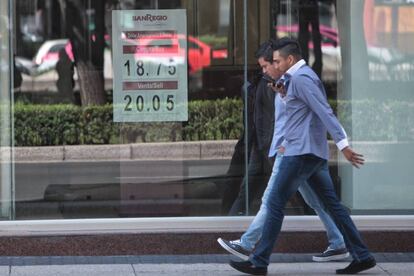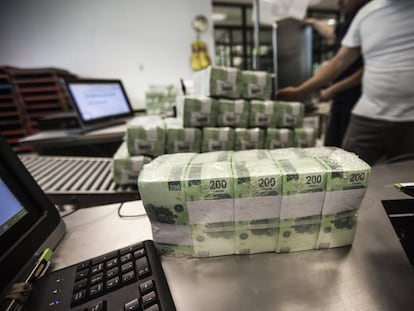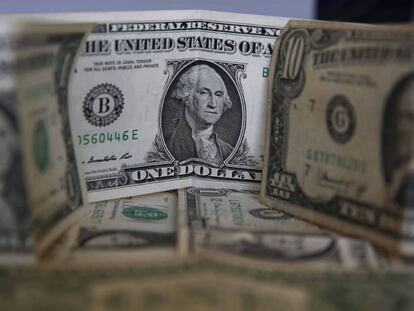How the United States interest rate hike will have an effect on Mexico
Central lender Banxico is expected to respond by raising its rates by 0.25%

The latest interest rate hike in the United States was expected. Mexico had been reinforcing its shock absorbers for more than a year, well before the US Federal Reserve (Fed) announced this week that the decade of “open bar” policy was over. Given the size of the rise – a quarter of a point, from 0.50% to 0.75% – and how predictable the decision was, the impact will be minimal.

But every tremor than runs through the American economy causes a shockwave in its southern neighbor. These are the consequences of the Fed decision.
Banxico’s reaction. Saying goodbye to cheap money in the United States has put constant pressure on the peso and other emerging-market currencies. Inflationary pressures have forced the Bank of Mexico to act resolutely. In January, the Fed’s 0.25% raise on interest rates was met with an equal and almost automatic hike in Mexico, bringing rates to 3.25%. Banxico has increased rates five times so far this year and those changes have led to a 5.25% interest rate. The bank’s director’s board will meet tomorrow and it is expected to raise rates one more time by 0.25% to match the Fed’s move. Banxico has been one of the most effective and trusted institutions throughout this crisis.
A strong dollar. The Mexican peso has been falling against the US dollar at record-breaking rates for months. Donald Trump’s victory confirmed that this state of affairs will stand in the medium-term. The Fed’s decision reinforces the situation but it does not make it worse. There has been minimal disruption in the currency markets. Greenbacks closed at 20.38 pesos, thus gaining 0.05% against the Mexican currency.
Disincentive for consumption and investment. The Fed sets the pace for the Bank of Mexico while Banxico sets the pace for the housing market. Credit markets reflected the more than two-point drop in the peso’s value. Average interest rates for mortgages reached 10.24% in October, the highest rate in a year and half, according to Banxico. The auto industry has been one of the most affected sectors. Credit loans for car purchases are at around 13% and banks say they will inevitably raise those rates in January.
Capital markets remain calm. The Bank of Mexico took resolute actions throughout the year to protect against capital flight. Foreign investor positions in short-term Mexican Federal Treasury Certificates (CETES) have declined over the last several months. Market analysts say the depreciation may simply be short-term profit-taking, pointing to robust federal reserves. The fact that the Mexican federal government is still managing its foreign debt held in dollars is also seen as a good sign.
English version by Dyane Jean François.
Tu suscripción se está usando en otro dispositivo
¿Quieres añadir otro usuario a tu suscripción?
Si continúas leyendo en este dispositivo, no se podrá leer en el otro.
FlechaTu suscripción se está usando en otro dispositivo y solo puedes acceder a EL PAÍS desde un dispositivo a la vez.
Si quieres compartir tu cuenta, cambia tu suscripción a la modalidad Premium, así podrás añadir otro usuario. Cada uno accederá con su propia cuenta de email, lo que os permitirá personalizar vuestra experiencia en EL PAÍS.
¿Tienes una suscripción de empresa? Accede aquí para contratar más cuentas.
En el caso de no saber quién está usando tu cuenta, te recomendamos cambiar tu contraseña aquí.
Si decides continuar compartiendo tu cuenta, este mensaje se mostrará en tu dispositivo y en el de la otra persona que está usando tu cuenta de forma indefinida, afectando a tu experiencia de lectura. Puedes consultar aquí los términos y condiciones de la suscripción digital.
More information
Archived In
Últimas noticias
The complicated life of Francesca Albanese: A rising figure in Italy but barred from every bank by Trump’s sanctions
How Japan is trying to avert ‘digital defeat’
Reinhard Genzel, Nobel laureate in physics: ‘One-minute videos will never give you the truth’
Pinochet’s victims grapple with José Antonio Kast’s rise in Chile
Most viewed
- Pablo Escobar’s hippos: A serious environmental problem, 40 years on
- Why we lost the habit of sleeping in two segments and how that changed our sense of time
- Trump’s obsession with putting his name on everything is unprecedented in the United States
- The Florida Keys tourist paradise is besieged by immigration agents: ‘We’ve never seen anything like this’
- Charles Dubouloz, mountaineering star, retires at 36 with a farewell tour inspired by Walter Bonatti










































